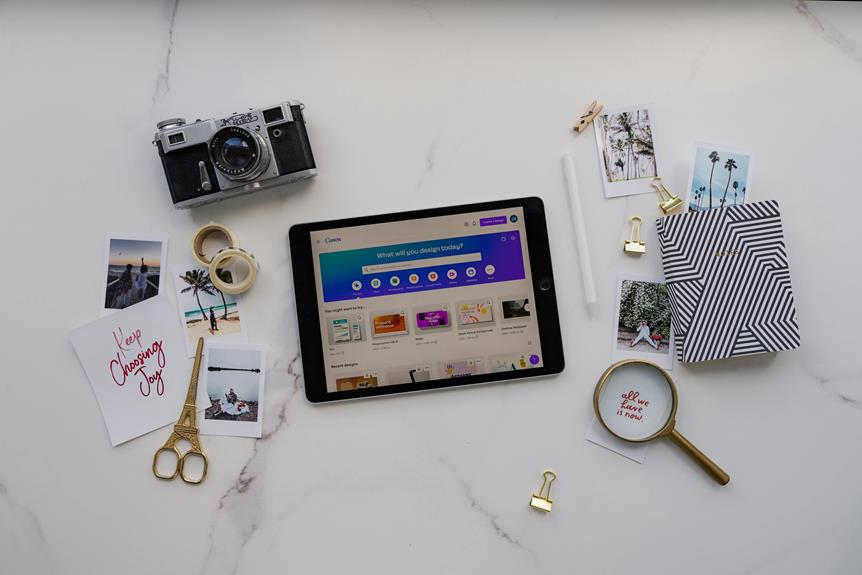
When moving from a point-and-shoot to a professional camera, start by honing in on your photography goals. Think about the type of photos you love capturing and your style preferences. Different camera types offer varied features: compact point-and-shoots are convenient, mirrorless options offer versatility, and DSLRs excel in optical viewfinders. Key features like sensor size and autofocus matter, so choose wisely based on your style. Consider your budget but remember, the price isn't always a marker of quality. Make informed decisions to enhance your photography journey with the right camera for you.
Understanding Your Photography Goals
Have you clearly defined your photography goals yet? Before diving into the world of cameras, it's crucial to have a clear understanding of what you want to achieve with your photography. Are you looking to capture stunning landscapes, candid moments with friends and family, or perhaps exploring the world of portrait photography? Defining your goals will help you narrow down the features you need in a camera and guide you towards the right choice.
Consider the types of photos you enjoy taking the most. Do you prefer capturing fast-action shots, experimenting with different lighting conditions, or focusing on intricate details? Understanding your photography style and preferences will play a significant role in selecting a camera that aligns with your needs. Whether you're a beginner looking to improve your skills or a hobbyist aiming to take your photography to the next level, knowing your goals will set the foundation for your camera choice.
Take some time to reflect on what you want to achieve with your photography. By clearly defining your goals, you'll be better equipped to choose a camera that suits your needs and helps you capture the moments that matter most to you.
Exploring Different Camera Types
Before selecting a camera, it's important to consider the various types available to suit your photography goals.
The first type to explore is the compact point-and-shoot camera. These are user-friendly, portable, and great for everyday use.
If you're looking to step up your game and have more control over settings, a mirrorless camera might be the way to go. Mirrorless cameras are lighter and more compact than DSLRs but offer similar image quality and interchangeable lenses.
On the other hand, DSLRs are known for their optical viewfinders and longer battery life, making them ideal for professional photographers or enthusiasts.
If you're into adventure or underwater photography, rugged compact cameras or action cameras could be your best bet due to their durability and waterproof capabilities.
Bridge cameras are a middle ground between compact and DSLR cameras, offering a powerful zoom range and manual controls.
Understanding these different camera types will help you make an informed decision based on your photography needs.
Key Features to Consider
When selecting a camera, focus on essential features that align with your photography style and preferences. One crucial feature to consider is the camera's sensor size. Larger sensors generally offer better image quality, especially in low light conditions.
Another key feature is the camera's megapixel count. While more megapixels can provide higher resolution images, they aren't the sole indicator of image quality. Consider the camera's autofocus system as well. A reliable autofocus system is essential, particularly for capturing fast-moving subjects.
Additionally, think about the camera's ISO range. A broader ISO range allows for better performance in various lighting situations. The camera's shooting speed, measured in frames per second, is also vital, especially for action photography.
Furthermore, pay attention to the camera's connectivity options. Wi-Fi and Bluetooth connectivity make it easier to transfer images to your devices.
Lastly, consider the availability of interchangeable lenses. Having the option to switch out lenses can greatly expand your creative possibilities. By focusing on these key features, you can select a camera that best suits your needs and helps you grow as a photographer.
Setting a Realistic Budget
Considering your financial constraints is a crucial step in determining the appropriate budget for your camera purchase. When setting a realistic budget, think about how much you're willing to invest in your photography journey.
Cameras come in a wide range of prices, from budget-friendly options to high-end professional models. It's essential to strike a balance between your needs and your budget. Take the time to research different camera brands and models to find one that fits your requirements without breaking the bank.
Keep in mind that your budget shouldn't only cover the camera body but also other essential accessories like lenses, memory cards, and camera bags. While it can be tempting to overspend on the latest and greatest gear, remember that a higher price tag doesn't always guarantee better quality.
Conclusion
Now that you've explored different camera types and key features, it's time to narrow down your options based on your photography goals and budget.
Whether you're looking for a simple point-and-shoot camera or a more advanced professional setup, there are plenty of choices out there to suit your needs.
Remember to do some research and try out different cameras before making your final decision.
Happy shooting!




